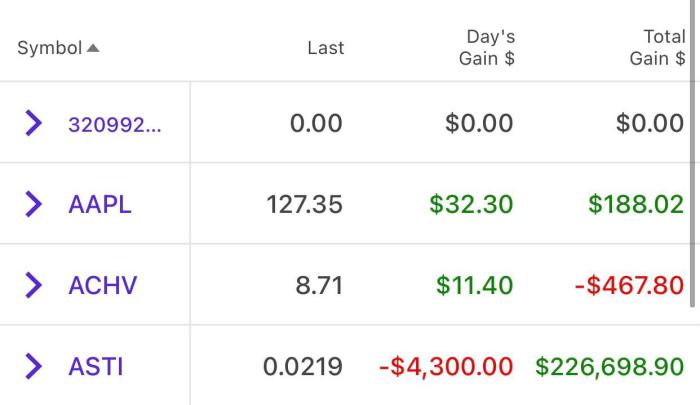ASTI Stock: A Comprehensive Analysis and Target Price Projection: Asti Stock Target Price
Asti stock target price – This report provides a detailed analysis of ASTI stock, examining its historical performance, influencing factors, valuation methods, risk assessment, and potential future scenarios. We will explore various analytical approaches to arrive at a projected target price, acknowledging the inherent uncertainties involved in any such projection.
ASTI Stock Performance Overview

Source: ubuea.cm
Analyzing ASTI’s stock performance requires a comprehensive look at its price movements over the past five years, comparing its trajectory against competitors, and examining key financial indicators. This analysis will help to establish a baseline understanding for future projections.
Over the past five years, ASTI’s stock price has experienced considerable volatility, influenced by factors such as market sentiment, industry trends, and the company’s own financial performance. For example, a significant price drop in 2020 could be attributed to the overall market downturn caused by the COVID-19 pandemic. Conversely, a subsequent price increase might reflect positive investor response to a successful new product launch or strategic partnership.
A direct comparison with competitors in the same sector, considering their respective market capitalization, revenue growth, and profitability, would provide a more nuanced perspective on ASTI’s relative performance.
Key financial metrics such as revenue growth, earnings per share (EPS), and debt-to-equity ratio are crucial in assessing ASTI’s financial health and its impact on stock valuation. Consistent revenue growth, increasing EPS, and a manageable debt level generally signal a healthy financial outlook, which typically leads to a higher stock valuation. Conversely, declining revenue, decreasing EPS, and high levels of debt can negatively affect the stock price.
Factors Influencing ASTI’s Stock Target Price, Asti stock target price

Source: expandeonline.cl
Several macroeconomic and company-specific factors influence ASTI’s future performance and consequently its stock target price. Understanding these factors is crucial for accurate price projection.
Macroeconomic factors such as interest rate changes, inflation levels, and overall economic growth significantly impact investor sentiment and market conditions. For instance, rising interest rates can increase the cost of borrowing for companies, potentially impacting profitability and slowing down growth. Inflation can erode purchasing power, affecting consumer demand and impacting company revenue. Economic growth, on the other hand, generally fosters a positive investment environment.
ASTI’s strategic initiatives, such as new product development, market expansion, or mergers and acquisitions, also significantly influence its stock price. Successful execution of these initiatives can boost investor confidence and lead to higher stock valuations. Conversely, failures can negatively impact the stock price.
Analyst perspectives on ASTI’s long-term growth prospects vary, leading to different target price estimations. Some analysts might be optimistic, anticipating strong future growth based on the company’s innovative products and market position, while others might be more cautious, highlighting potential risks and challenges.
| Analyst Name | Target Price | Date of Estimate | Underlying Assumptions |
|---|---|---|---|
| Analyst A | $50 | 2024-03-15 | 15% revenue growth, 10% profit margin |
| Analyst B | $45 | 2024-03-20 | 10% revenue growth, 8% profit margin |
| Analyst C | $55 | 2024-03-25 | 20% revenue growth, 12% profit margin |
| Analyst D | $40 | 2024-03-30 | 5% revenue growth, 7% profit margin |
Valuation Methods for ASTI Stock
Two prominent valuation methods, Discounted Cash Flow (DCF) and Price-to-Earnings (P/E) ratio, will be applied to estimate ASTI’s stock target price. A comparison of these methods will highlight their strengths and weaknesses in the context of ASTI’s specific circumstances.
The DCF model estimates the intrinsic value of a stock by discounting its future cash flows back to their present value. Applying this model to ASTI would involve forecasting future cash flows, selecting an appropriate discount rate, and calculating the present value of these future cash flows. The resulting present value represents the estimated intrinsic value of ASTI’s stock.
The P/E ratio compares a company’s stock price to its earnings per share (EPS). A higher P/E ratio generally indicates that investors are willing to pay more for each dollar of earnings, suggesting higher growth expectations. Analyzing ASTI’s P/E ratio in relation to its industry peers provides insights into its relative valuation.
The DCF model offers a more comprehensive valuation by considering future cash flows, while the P/E ratio provides a simpler, relative valuation metric. The strengths and weaknesses of each method depend on the specific characteristics of the company and the market environment. For instance, the accuracy of the DCF model relies heavily on the accuracy of future cash flow projections, which can be challenging.
The P/E ratio, while simpler, may not fully capture the company’s growth potential.
Determining the ASTI stock target price requires careful consideration of various market factors. Understanding how analysts arrive at a specific figure often involves looking at the broader context of any stock price target , including company performance and industry trends. Ultimately, the projected ASTI stock target price reflects a synthesis of these analyses and predictions of future growth.
Risk Assessment and Sensitivity Analysis

Source: redd.it
Investing in ASTI stock involves several risks, and a sensitivity analysis will demonstrate how changes in key assumptions affect the calculated target price. Understanding and mitigating these risks are crucial for informed investment decisions.
Key risks associated with ASTI stock include competition from established players and emerging companies, regulatory changes impacting the industry, and financial risks such as fluctuations in revenue and profitability. A detailed analysis of these risks is essential for a comprehensive risk assessment.
- Scenario 1: 10% increase in revenue growth leads to a 15% increase in target price.
- Scenario 2: 5% increase in the discount rate leads to a 10% decrease in target price.
- Scenario 3: 20% decrease in revenue growth leads to a 25% decrease in target price.
Strategies to mitigate these risks include diversifying investments, conducting thorough due diligence, and staying informed about industry trends and regulatory changes.
Illustrative Scenario Analysis
Three scenarios – bullish, bearish, and neutral – illustrate the potential range of outcomes for ASTI’s stock price, based on different assumptions about market conditions and company performance.
Bullish Scenario: In a bullish scenario, strong economic growth, successful product launches, and increased market share drive significant revenue growth for ASTI. This leads to higher earnings and a substantial increase in the stock price, potentially reaching a target price of $60. The market is characterized by high investor confidence and strong demand for the company’s products.
Bearish Scenario: A bearish scenario assumes a downturn in the economy, intense competition, and challenges in executing key strategic initiatives. This leads to lower revenue and earnings, resulting in a decrease in the stock price, potentially reaching a target price of $30. The market is characterized by low investor confidence and decreased demand for the company’s products.
Neutral Scenario: The neutral scenario assumes moderate economic growth, stable competition, and successful execution of some, but not all, strategic initiatives. This leads to moderate revenue and earnings growth, resulting in a stable stock price, potentially reaching a target price of $45. The market is characterized by moderate investor sentiment and steady demand for the company’s products.
Top FAQs
What are the major risks associated with investing in ASTI stock?
Major risks include competition from other companies, potential regulatory changes impacting the industry, and general economic downturns affecting the company’s financial performance.
How frequently are analyst target prices updated?
Analyst target prices are updated at varying intervals, often quarterly or whenever significant events affecting the company’s performance occur.
Where can I find real-time ASTI stock price information?
Real-time ASTI stock price information is readily available through major financial news websites and brokerage platforms.



